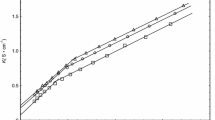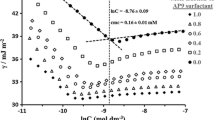Abstract
Heats of micelle formation were estimated from calorimetric measurements of anionic surfactants to see if there is any effect of the electrical charge of the counterion on micelle formation from the viewpoint of enthalpy change. The cationic counterions used are Na+ and Cu2+ for the concentrated electric charge, MV2+ for the diffused and 1,1′-(1,ω)-alkanediyl)bispyridiniumions
n=2, 4, 6, 8, 10, 12, 14 for the separated. The heat of micelle formation was obtained by subtracting an enthalpy change of dissolution of surfactant solid precipitated below the micelle temperature range (MTR or Krafft point) from a heat of complete dissolution of the precipitated surfactant solid around the MTR. The heats thus evaluated were found to be much more temperature-dependent than counterion-dependent. They were compared with the enthalpy change calculated from the CMC change with temperature, and the big difference between them was discussed from a thermodynamic point of view.
Similar content being viewed by others
References
Moroi Y, Ikeda N, Matuura R (1984) J Coll Interf Sci 101:285
Moroi Y, Sugii R, Akine C, Matuura R (1985) J Coll Interf Sci 108:180
Moroi Y, Matuura R, Kuwamura T, Inokuma S (1986) J Coll Interf Sci 113:225
Phillips JN (1955) Trans Faraday Soc 51:561
Goddard ED, Hoeve CAJ, Benson GC (1957) J Phys Chem 64:593
Matijevic E, Pethica BA (1958) Trans Faraday Soc 54:587
Pilcher G, Jones MN, Espada L, Skinner HA (1969) J Chem Thermodynamics 1:381
Espada L, Jones NM, Pilcher G (1970) J Chem Thermodynamics 2:1
Paredes S, Tribout M, Ferreira J, Leonis J (1976) Coll Polym Sci 254:637
Birdi KS (1983) Coll Polym Sci 261:45
Moroi Y (1988) J Coll Interf Sci, in press
Satake I, Ikenoue T, Takeshita T, Hayakawa K, Maeda T (1985) Bull Chem Soc Jpn 58:2746
Satake I, Iwamatsu I, Hosokawa S, Matuura R (1963) Bull Chem Soc Jpn 36:204
Moroi Y, Sugii R, Matuura R (1984) J Coll Interf Sci 98:184
Prigogine I, Defay R (1967) Chemical Thermodynamics, Longmans, London
White P, Benson GC (1959) Trans Faraday Soc 55:1025
Moroi Y, Nishikido N, Uehara H, Matuura R (1975) J Coll Interf Sci 50:254
Muller N (1977) In: Mittal KL (ed) Micellization, Solubilization, and Microemulsions, Vol 1, Plenum Press, New York, p 229
Robinson RA, Stokes RH (1970) Electrolyte Solutions, Butterworths, London
White P, Benson GC (1958) J Coll Sci 13:584
Author information
Authors and Affiliations
Rights and permissions
About this article
Cite this article
Moroi, Y., Matuura, R., Kuwamura, T. et al. Heat of micelle formation: Effect of counterions with concentrated, diffused, and separated electric charges. Colloid & Polymer Sci 266, 374–379 (1988). https://doi.org/10.1007/BF01451822
Received:
Accepted:
Issue Date:
DOI: https://doi.org/10.1007/BF01451822




